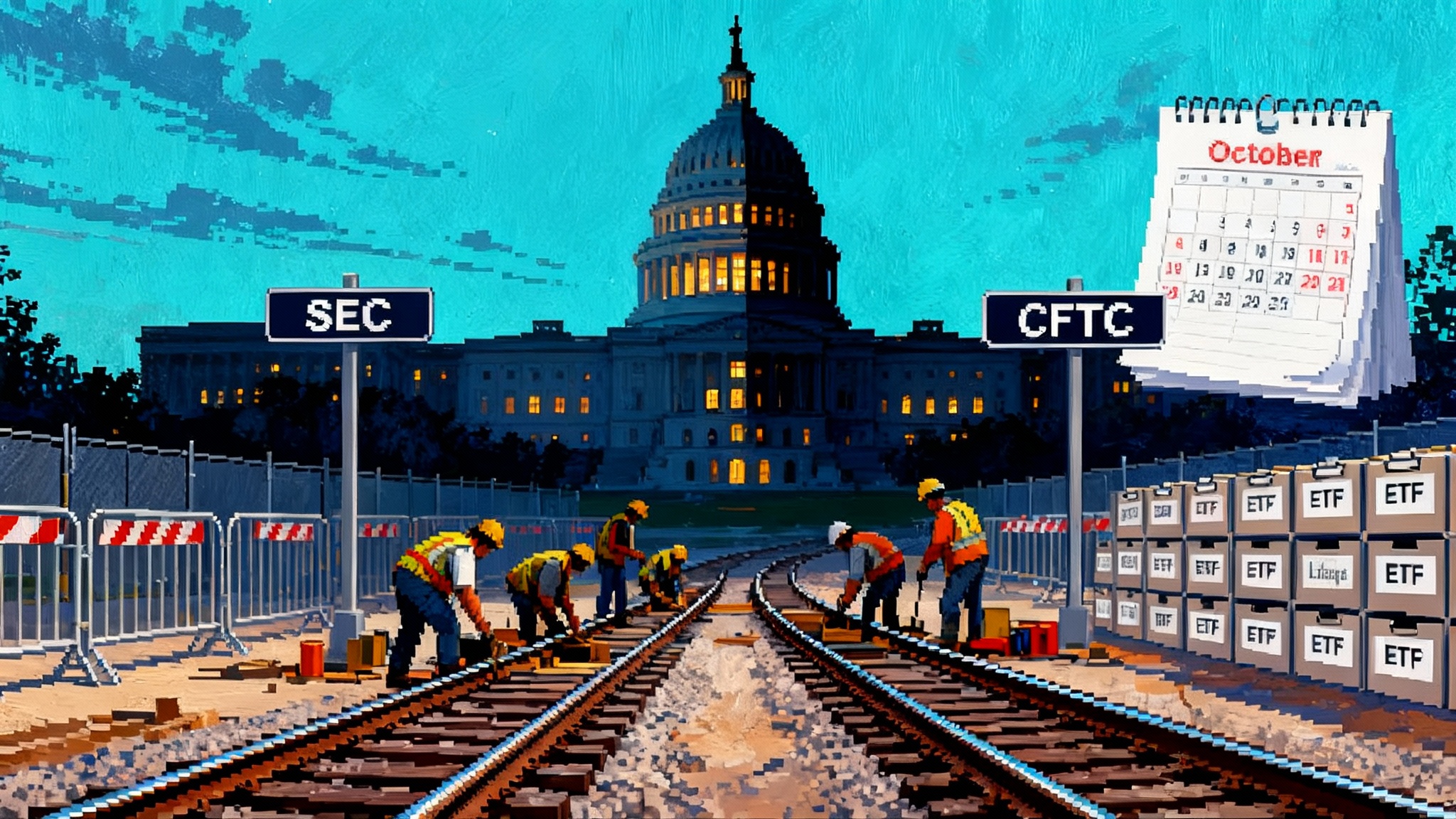Shutdown and Senate Stalemate Jolt Crypto’s Rulebook
A Senate breakdown and a federal shutdown collided this week, freezing the digital asset agenda. Here is how a prolonged impasse could shift SEC and CFTC power, reshape DeFi carveouts, stall listings and ETFs, and how to keep building through it.

The week that reset crypto’s timeline
On Thursday, October 9, Senate talks over an all-in-one digital asset market structure bill frayed in public. Members who had sounded optimistic earlier in the fall ended the week pointing fingers about process and policy. The details matter because this bill is the one that would draw the bright line between what the Securities and Exchange Commission polices as securities and what the Commodity Futures Trading Commission oversees as commodities. When Senate talks broke down on October 9, the calendar slipped and the center of gravity shifted.
At the very same time, the United States government shutdown that began on October 1 throttled financial regulators. The Securities and Exchange Commission, operating with a skeletal team, said it would keep EDGAR open but would not declare new registration statements effective. That is the roadblock that can hold up token listings, exchange approvals, and exchange traded funds. The agency laid out those constraints in its SEC shutdown operating plan.
Two events in one week do not just slow the headline legislative project. They change the sequence of who decides, and when. In plain English, a prolonged impasse turns Washington’s neat flowchart into a choose-your-own-adventure. When Congress stalls, agencies fall back to existing authority, courts step forward, and states look for their own solutions. That rebalance is already visible, and it will shape product roadmaps and capital allocation through 2026.
Why a long stalemate matters
Think of crypto’s legal architecture like a city zoning code that has never been fully updated for mixed-use buildings. Everyone agrees a skyscraper is commercial and a single-family home is residential. The fight is about live-work lofts with a storefront on the ground floor and a co-op upstairs. Tokens can look like that. Some behave like investment contracts at launch, others look like commodities once networks are live. The market structure bill aimed to codify where the border fence goes. With the bill on ice and regulators slowed by the shutdown, the border patrols work from old maps.
Who calls what a security
Without new law, the Securities and Exchange Commission will keep leaning on the Howey test and similar case law to argue that many token distributions are securities offerings. The Commodity Futures Trading Commission will continue to treat spot trading as largely outside its remit while supervising derivatives and policing fraud and manipulation. A compromise bill could have moved thousands of tokens into a commodities-like regime once they crossed measurable decentralization thresholds. The stalemate means that handoff remains unclear.
In practice, that uncertainty pushes activity toward the edges that are already defined. That means more futures products on venues the Commodity Futures Trading Commission already regulates, more cautious rules of the road for spot platforms that want to look like national securities exchanges, and more legal testing around when a token can migrate from one category to another. The center lane that Congress was paving stays coned off.
How the debate could harden or soften decentralized finance carveouts
Decentralized finance, which is the term for services delivered by software protocols rather than traditional intermediaries, has been the hardest chapter to draft. One camp wants a narrow carveout that recognizes the difference between code and custodial middlemen. Another camp argues that the front end and governance structures are where consumer protection must land, even if the protocol itself is self-executing.
If the stalemate drags on, expect two opposite gravitational pulls. Enforcement-first regulators will focus on teams that run user interfaces, token distribution schedules, or administrative keys, and they will frame those as the functional equivalent of brokers or transfer agents. On the other side, state-level experiments may widen safe operating zones for protocols that meet objective decentralization and disclosure benchmarks. With no federal deal, both forces get stronger. The carveout you get depends on which forum you face first.
Why token listings could slow then splinter
Listings are where legal risk meets business incentives. In a world with clear federal lanes, a national exchange might add a token after a documented analysis and a standard disclosures package. In this world, platforms will sort tokens into three bins. The first bin holds networks that look like commodities today, backed by long trading histories and no central promoter. The second bin holds projects that can pass a robust decentralization and disclosure screen. The third bin holds everything else, which will stay dark until there is either a law or a court precedent that points the way.
This is not just about major players. Regional and specialty platforms will make different calls, especially if they are licensed under state charters that allow spot trading with specific consumer protection add-ons. That could create a patchwork in which a token is widely available in some states, available with guardrails in others, and unavailable in the most conservative jurisdictions. Fragmentation is a cost, but it is also a live market signal about what kinds of disclosures and distribution histories lower legal risks.
The altcoin exchange traded fund queue will get lumpier
The first generation of crypto exchange traded funds made it through when the legal status of the underlying asset was well litigated or a deep futures market existed. A comprehensive market structure law might have provided a clearer route for exchange traded products tied to other large networks. The shutdown blocks the mechanics of approvals in the near term. The stalemate extends the uncertainty after the shutdown ends because staff will sift filings with the same pre-impasse standards. Expect sponsors to borrow lessons from capital markets trends we covered when Nasdaq lights the RWA fuse.
Expect three things. First, a backlog that clears in batches once operations fully resume. Second, more conservative product design, such as futures-based exposure or funds that rely on robust surveillance sharing agreements with major venues. Third, more attention to custody, staking policies, and chain-specific risks in prospectuses, because these become the hinge points for approval and for litigation.
Three plausible paths through 2026
Scenario planning is not a parlor game here. It is product and portfolio strategy. Here are three paths, each with distinct signals to track and clear implications for builders and investors.
Scenario A: Congress passes a compromise in mid-2026
Under this path, the Senate reconciles internal differences, aligns with elements of the House approach, and sends a compromise to the President by mid-2026. The compromise draws a functional perimeter around tokens that meet a decentralization threshold, sets a supervised on-ramp for token distributions, and establishes disclosure templates that differ from traditional public company filings. It also includes a narrow decentralized finance carveout that exempts the protocol layer when there is no administrative control and when interfaces provide specified risk warnings and block sanctioned addresses.
Implications:
- Listings accelerate for assets that meet the threshold and provide standardized onchain disclosures.
- The Commodity Futures Trading Commission becomes the day-to-day cop for spot market conduct rules for qualifying tokens, while the Securities and Exchange Commission focuses on token distributions, staking and yield programs, and platforms that look functionally like brokerages.
- Exchange traded fund sponsors file new applications keyed to the statutory tests, and the review cycle becomes more predictable.
Signals: A joint framework from the Senate Banking and Agriculture Committees, public comments from centrist Democrats endorsing a middle path, and staff drafts that replace principles with checklists.
Scenario B: No bill; courts and states set the rules of the road
If negotiations fail and the calendar runs into the 2026 election cycle, federal courts and state regulators fill the vacuum. In this world, a handful of appellate decisions define when a token distribution is a securities offering and clarify that live networks with no control person can trade as commodities. States like New York, Wyoming, and Texas update or clarify licensing regimes to incorporate decentralization and disclosure metrics. California’s state securities regulator and financial protection agency step up coordinated actions on retail-facing yield products and interfaces that look like brokerages.
Implications:
- Exchanges cluster around state frameworks that are stable and court tested. This rewards teams that can prove technical decentralization and provide machine-readable risk disclosures.
- The Commodity Futures Trading Commission remains the anchor for derivatives and anti-manipulation rules, but spot conduct standards vary by license type and state.
- Exchange traded fund approvals continue but tilt toward assets with deep surveillance and custody ecosystems that can be defended under existing securities law.
Signals: Divergent state guidance on token listings and automated market makers, a run of court rulings that carve out live networks, and an industry shift toward state-chartered entities for spot trading and custody.
Scenario C: Partial federal action plus agency rulemaking
A third path is a narrow law on one slice, such as stablecoins, combined with agency rulemaking and guidance. The law creates a foundation. The Securities and Exchange Commission and Commodity Futures Trading Commission then publish parallel guidance on token distribution disclosures, exchange obligations, and cross-market surveillance. Recent payments debates, including how the GENIUS Act sparks payments land grab, preview the contours of this approach.
Implications:
- Builders adapt to checklists that look like a hybrid of securities offering circulars and commodities market conduct rules.
- Decentralized finance interfaces register as something akin to alternative trading systems if they route orders, or they decentralize enough to stay outside those definitions.
- Exchange traded fund sponsors re-file with custody and pricing disclosures that track to the new guidance, with decisions arriving in clumps as staff completes thematic reviews.
Signals: Committee staff circulate narrow bill text, the securities and commodities regulators issue concept releases seeking comment on token classifications, and self-regulatory organizations propose surveillance rules specific to crypto order flow.
An accelerationist playbook for Q4 2025 through 2026
You do not need to guess the winner to get positioned. You need to build for optionality with concrete gates, triggers, and disclosures. Here is a practical playbook.
- Design for multiple outcomes at the protocol and product layer.
- Implement a switchboard architecture. Ship modules that can operate in three modes: registered security, supervised commodity spot asset, or overseas-only utility. Document in code comments and technical papers how each mode changes staking, governance, and token economics. Patterns emerging in L2 design, such as how Arbitrum’s BoLD flips the switch, can inform this modular approach.
- Prepare a global routing policy. Geofence features based on jurisdiction. Make the routing rules auditable so exchanges and custodians can verify compliance without bespoke integrations.
- Align with decentralization thresholds you can measure.
- Publish a decentralization dossier that lives onchain. Track validator concentration, client diversity, treasury control, governance participation, and upgrade procedures. Report these metrics quarterly with signed attestations from third-party auditors.
- Automate the key turn. If upgrades require multi-sig control today, set a dated sunset and a contingency plan for emergency fixes that does not re-centralize the network.
- Treat disclosures as a product, not paperwork.
- Build a standardized packet that mirrors what regulators keep asking for: token distribution schedules, treasury policies, related party transactions, custody and key management, protocol risk factors, and a plain-English explainer of how users could lose money.
- Render the packet in machine-readable form. Give exchanges, data vendors, and custodians the same stable schema. If a law arrives, you are already 80 percent there.
- Separate the protocol from the interface.
- If you operate a front end, design it like a broker interface would be designed. Offer standardized risk warnings, transaction previews that show price impact and fees, and opt-in travel rule compliance where applicable. If you do not need to run a front end, publish reference code and let independent teams build alternatives.
- Build custody and controls that work across regimes.
- For institutions, provide a custody design that supports segregation, bankruptcy-remote arrangements, and auditable staking or delegation policies. Document how you would unwind positions during a trading halt or a chain reorganization.
- For consumers, offer clear guidance on self-custody with recovery options that do not compromise security. Make the tradeoffs obvious.
- Have a listings strategy that matches your risk profile.
- Create a three-tier exchange plan. Tier one is exchanges that operate under the most conservative interpretations, likely with national securities exchange ambitions. Tier two is state-licensed or offshore exchanges with strong compliance teams. Tier three is long-tail venues that you will not touch until litigation or law changes the calculus.
- Pair each tier with a disclosure level. The more conservative the venue, the more detailed and frequent your disclosures should be.
- Plan for a messy exchange traded fund market.
- If your asset is a credible candidate, invest early in robust price discovery and surveillance partnerships. Encourage multiple high-quality market makers and publish reference rates and methodology.
- Expect batching. Under a shutdown hangover, staff will clear similar products together. That rewards teams that solve custody and pricing questions in a way that can be reused across filings.
- Stage your legal bets.
- Map the lawsuits that could define your category and track the procedural posture. File amicus briefs where you have unique expertise to offer. Do not hinge your roadmap on any single case, but do design for a world where a favorable appellate decision arrives before Congress acts.
- Use state cycles to your advantage.
- Engage with New York’s virtual currency unit if you plan to seek a listing under its oversight. Study Wyoming’s bank charters for digital asset activities and how they intersect with national bank partners. Track California’s financial protection priorities, especially for retail-facing yield.
- Pilot programs in states that publish clear criteria for token availability, disclosures, and custody. Take those learnings back into national conversations.
- Prepare investor communications that assume volatility in rules and timelines.
- Replace vague promises with conditional plans. Spell out what you will do if Congress passes a law by mid-2026, or if courts deliver clarity first, or if neither happens. Tie each plan to budget and headcount so investors can evaluate tradeoffs.
- Update quarterly with a regulatory dashboard. Include the status of key filings, audits, cases, and state licenses. Treat policy risk the same way you treat smart contract risk.
What to watch in the next 90 days
- Shutdown duration. Every week that agencies run with limited staff adds to the backlog that hits when the lights come back on. Companies with time-sensitive filings should assume a restart surge and plan to resubmit clean, final documents.
- Committee signals. If Senate committees publish draft sections with concrete tests for decentralization or disclosure templates, that is a sign that a compromise is possible. If talks stay stuck on decentralized finance and market oversight turf, prepare for the courts-and-states path.
- State guidance. Look for updated token-listing frameworks from New York and enforcement priorities from California. Monitor whether other states adopt safe harbors for truly decentralized protocols that meet public disclosure checklists.
- Exchange behavior. Watch how major platforms like Coinbase and Kraken adjust listings and staking services. Their risk posture is a proxy for where counsel believes the wind is blowing.
- Product design from large asset managers. If the next wave of exchange traded fund filings shift toward futures-based exposure or multi-asset baskets with strict surveillance and custody language, that signals how sponsors are adapting to a slower federal pivot.
The bottom line
This week delivered a one-two punch that few expected to land together. The Senate’s breakdown froze the timetable for a comprehensive map of the crypto market. The shutdown cut power to the agencies that turn legislative language into daily green lights. Together they change who leads in the near term and how quickly new products can reach investors.
Builders and investors do not have to wait for certainty. Design for forks, publish the facts that matter, separate what must be centralized from what can be automated, and keep options open across venues and jurisdictions. If clarity comes from Congress by mid-2026, the teams that built to measurable thresholds will move first. If the courts and states move the ball instead, those same teams will already speak the language that new rules will adopt. The market rewards readiness, especially when the rulebook is being written in real time.








